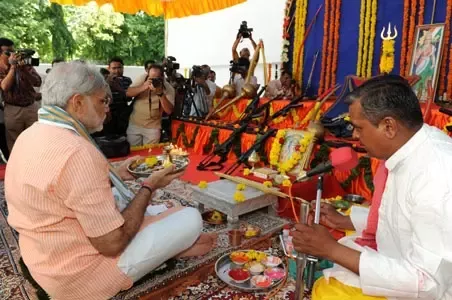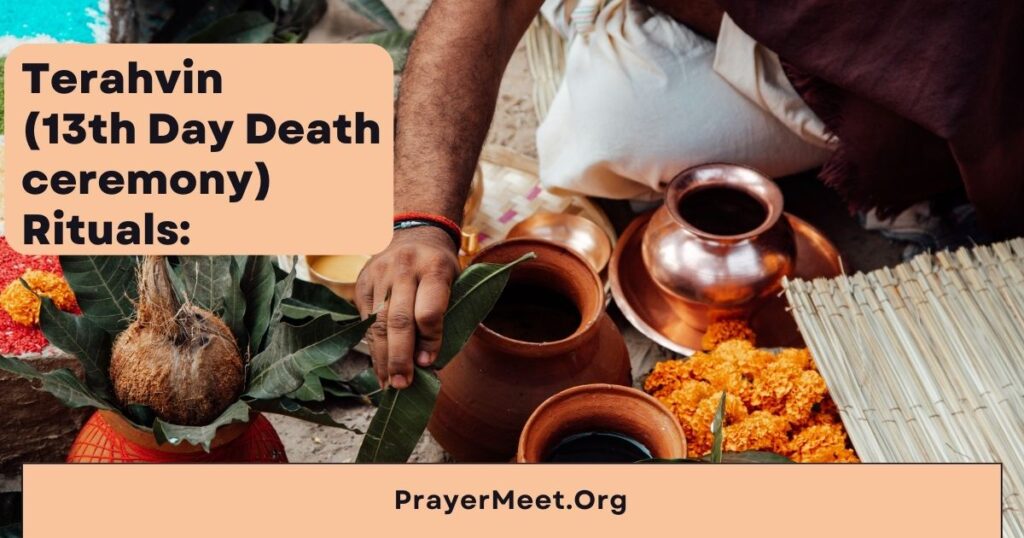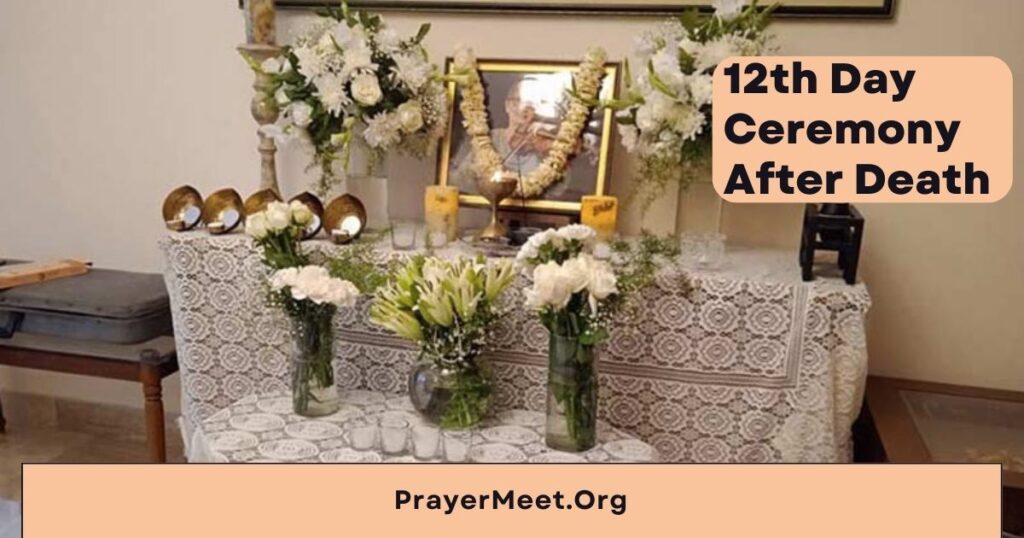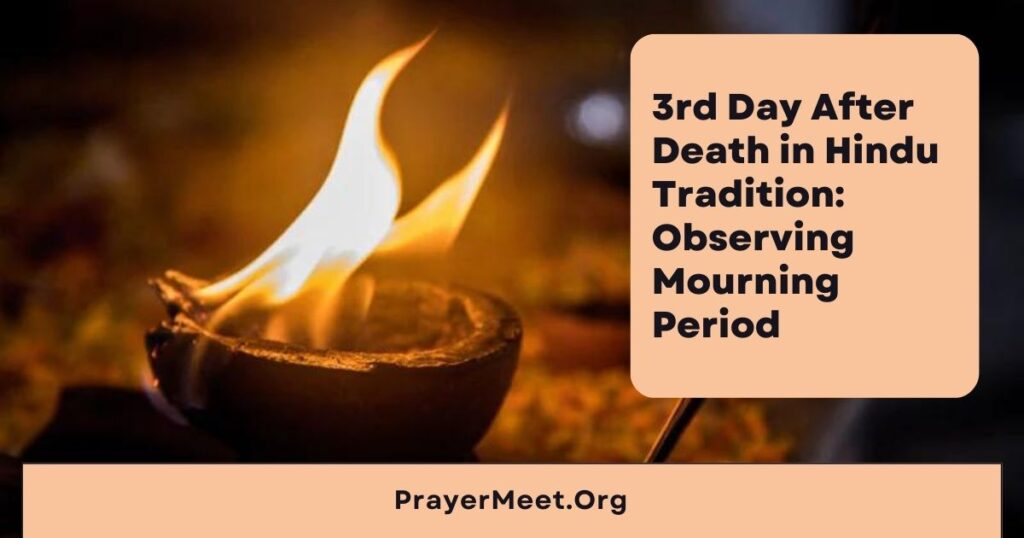Losing a loved one is a deeply emotional experience that leaves us with a profound sense of loss. During this challenging period, it becomes crucial to find solace, support, and understanding in our traditions and rituals. The Terahvin, also known as the 13th Day Ceremony after death, holds a special place in Indian culture as a way to honour and remember our departed loved ones. As we discuss this sensitive topic, let us acknowledge the heaviness in our hearts and extend our deepest condolences to all those who are grieving the loss of someone dear to them.
Dear Readers,
I feel so sorry for the great loss. As a Sharandhajali singer, I truly understand what you have been going through in this painful time. But don’t worry, you are not alone in this. My prayers and well wishes are with you.
So, let’s understand the meaning, rituals, mourning period, invitation etiquette, and observance of Sutak during Terahvin.
Terahvin: The 13th Day Death Ceremony Meaning:

Terahvin is the most crucial day of saying a final goodbye to the loving soul who left us behind. Terahvin, called Pind Sammelan or Spindi, emerges as a beacon of hope and remembrance. This sacred ritual, performed on the 13th day after the passing of a beloved soul, signifies our longing to reunite the departed with their ancestors and with God. We recognize the depth of pain people go through, and we stand with you in solidarity during this challenging time.
Terahvin (13th Day Death ceremony) Rituals:

Amidst a recent Shradhanjali samaroh somewhere in North India, we discussed the profound rituals of the Terahvin. The atmosphere was filled with a mixture of grief and reverence as the Pathēya shrāddha and Nidhan Shanti rituals were explained.
Amid this overwhelming sadness, It is important to gather all near and dear ones and offer them a sweet meal as a symbolic gesture of love and unity. These rituals provide moments of solace and respite, allowing us to express our emotions and take steps toward healing.
13th Day Post Death Ceremony Purpose and Significance:
During this time I understand what painful thoughts come to the people who are left behind. The purpose and significance of the 13th Day Ceremony shine through as a guiding light. These rituals hold the power to elevate the subtle body, the linga-dēha, beyond earthly attachments and towards a spiritual destiny.
As the family of the deceased grapples with the pain of saying goodbye, people should gather in the process of detachment from the physical body and the blossoming of a deep connection with God. Together, let us find the strength to navigate through this challenging period.
13th Day Mourning Period in Hinduism:
In the wake of a loved one’s departure, a period of intense mourning engulfs our lives. During this time, the family of the deceased is regarded as impure and must adhere to various rules of conduct, including:
- Remaining primarily in the family home throughout this period.
- Abstaining from attending religious functions or celebrations.
- Avoiding the reading or recitation of holy scriptures.
- Restricting the consumption of certain foods, such as sweets.
- Refraining from touching or approaching the family shrine.
- Not visiting other family or friends, although relatives may visit the bereaved.
These thirteen days provide an opportunity for the family and friends of the departed to freely express their grief, rather than suppressing it. Hindu mourning rituals are designed to encourage the open expression of emotions, as it is believed that this promotes physical well-being and prevents the negative effects of unresolved grief and anger.
How to Calculate the 13th Day After Death?
In the days of grief, time becomes both a companion and a burden. Calculating the 13th day after the loss of a loved one is a task that requires attention to detail. The duration of mourning, which spans 13 days, is calculated from the moment of death rather than the time of cremation.
Therefore, it is crucial to perform the cremation promptly after the passing. In some instances, there have been cases where the cremation took place two weeks after the demise. However, it is important to note that the mourning ceremonies cannot commence until the body has been respectfully laid to rest. Each passing day brings you closer to the completion of this period, as you navigate the intricate path of grief and healing.
What Do Hindus Do in a Terahvin?
As we reflect on the Terahvin, it is essential to understand the rituals and practices that form the foundation of this ceremony. During this time, Prashad is distributed and families come together to offer prayers, perform rituals, and express their love and respect for the departed soul.
The atmosphere is filled with a bittersweet combination of grief and remembrance, as hymns and chants resonate in honour of the departed. It is a time for deep introspection, where we honour the memories of our loved ones and seek solace in the embrace of our traditions.
How Do You Invite to the 13th Day of the Death Ceremony?
The process of inviting loved ones to join you in the observance of the 13th-day death ceremony is a heartfelt gesture that acknowledges the support and solidarity needed during this challenging time. It is important to convey your emotions and intentions with sincerity.
A warm and personal invitation, whether through a written note, a phone call, or an intimate conversation, helps create a sense of unity and comfort as you come together to honour and remember your loved one.
What Is the 13th Day Ritual Invite?
The 13th-day ritual invite serves as a bridge that connects your grieving heart with the compassionate souls who share in your sorrow. It is an invitation to come together, offer prayers, share stories and memories, and seek solace in each other’s presence.
While the format of the invitation may vary, its essence remains the same – a heartfelt request to join you on this important day as you pay homage to your departed loved one. Let your invitation reflect the love, warmth, and reverence that your family holds, ensuring that it conveys the profound significance of this ceremony.
How Do You Write a Death Ceremony Invitation?
Writing a death ceremony invitation is an emotional task that requires a delicate balance of compassion and clarity.
Invitation template –
[Your Name]
[Address]
[Date]
Dear [Recipient’s Name],
We hope this invitation finds you well.
As a loving family, we would like to invite you to join us for the 13th-day death ceremony in the loving memory of [Deceased’s Name]. We understand the significance of your presence during this challenging time and would be grateful to have you stand by our side.
Date:
Time:
Location:
Your presence and support would mean a lot to us as we honour and remember our beloved [Deceased’s Name].
We kindly request you to join us for the final farewell to our dear [Deceased’s Name].
[Your Name]
[Contact Information]
Why Do Hindus Observe Sutak After a Death in a Nearby Family?
In the wake of a loved one’s passing, Hindus observe a period of abstention known as Sutak. This period of renunciation, lasting twelve to sixteen days, is observed by all family members and relatives of the deceased. Sutak, also referred to as Patak represents a time of withdrawal from regular daily activities and a focus on mourning and introspection.
By adhering to the rules and regulations of Sutak, individuals show respect for the departed and seek spiritual purification. It is a time to reflect on the transient nature of life and to find solace in the collective support of the community.
What Happens After the 13th Day of Hindu Funeral?
As the 13th day of the Hindu funeral rituals draws to a close, a new phase of remembrance and healing begins. While the formal mourning period may conclude, the love and memories of the departed remain etched in our hearts. It is a time to cherish the moments shared, honour their legacy, and find comfort in the support of loved ones.
Healing is a gradual process, and it is essential to be patient and kind to yourself as you navigate the path forward. Know that you are not alone, and your loved one’s spirit will forever guide you on this journey.
Other Articles to Read:
- Prayer Meet Invitation: Remembering and Paying Tribute
- What Exactly is Life After Death?
- 3rd Day After Death in Hindu Tradition
- 12th Day Ceremony After Death
- 16 days After Death: Pitru Paksha
- Death 11th Day Ceremony
It is important to remember that you are not alone in your grief. It is your strength and resilience that truly matter. I understand the pain that accompanies the loss of a cherished soul.
Our words can only offer solace to an extent, but we hope that they provide a comforting embrace during this difficult time.
May the Terahvin ceremony and the rituals associated with it provide you and your family with the strength and healing needed to navigate the profound journey of grief. Remember, dear reader, that you are not alone, and I stand with you in solidarity and compassion.
Charan ji


